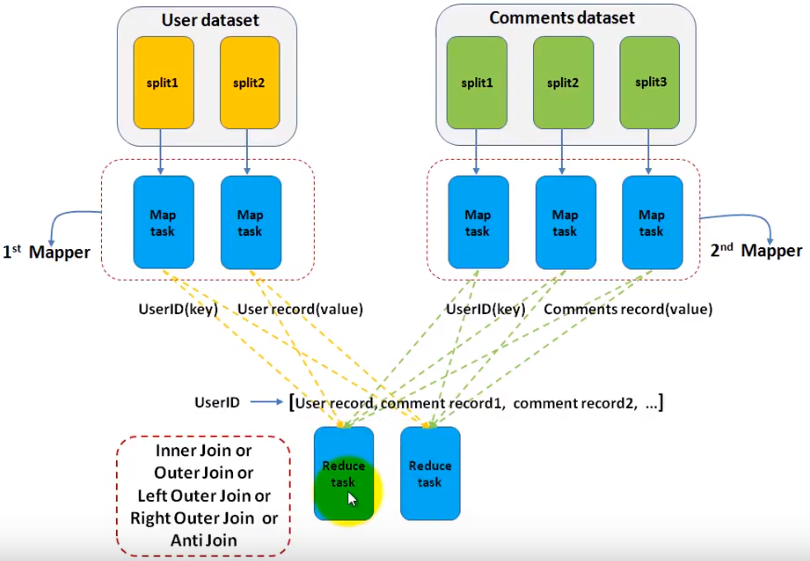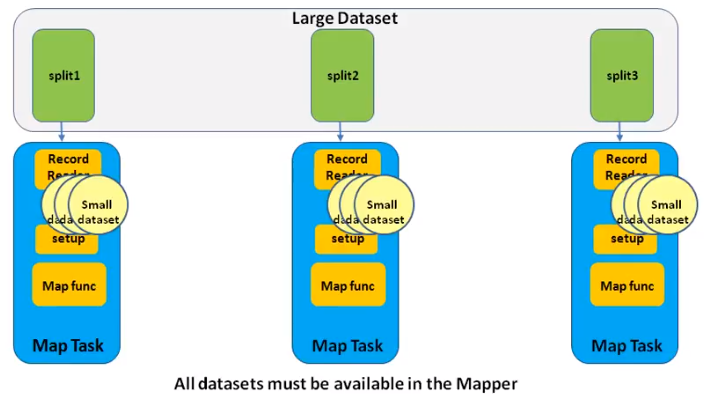Map Reduce Application(Join)
We are going to explain how join works in MR , we will focus on reduce side join and map side join.
Reduce Side Join
Assuming we have 2 datasets , one is user information(id, name...) , the other is comments made by users(user id, content, date...). We want to join the 2 datasets to select the username and comment they posted. So, this is a typical join example. You can implement all types of join including innter join/outer join/full outer join... As the name indicates, the join is done in reducer.
- We use 2/n mappers for each dataset(table in RDBMS). So, we set this with code below.
MultipleInputs.addInputPath(job,filePath,TextInputFormat.class,UserMapper.class)
MultipleInputs.addInputPath(job,filePath,TextInputFormat.class,CommentsMapper.class)
3 ....
4 MultipleInputs.addInputPath(job,filePath,TextInputFormat.class,OtherMapper.class)
.... - In each mapper, we just need to output the key/value pairs as the job is most done in reducer. In reduce function, when it iterators the values for a given key, reduce function needs to know the value is from which dataset to perform the join. Reducer itself may not be able to distinguish which value is from which mapper(UserMapper or CommentsMapper) for a given key. So, in the map function, we have a chance to mark the value like prefix the value with the mapper name something like that.
outkey.set(userId);
//mark this value so reduce function knows
outvalue.set("UserMapper"+value.toString);
context.write(outkey,outvalue) - In reducer, we get the join type from configuration, perform the join. there can be multiple reducers and with multiple threads.
public void setup(Context context){
joinType = context.getConfiguration().get("joinType");
}
public void reduce(Text text, Iterable<Text> values, Context context)
throws Exception {
listUser.clear();
listComments.clear();
for (Text t: values){
if(isFromUserMapper(t)){
listUser.add(realContent(t));
}else if (isFromCommentsMapper(t)){
listUser.add(realContent(t));
}
}
doJoin(context);
}
private void doJoin(Context context) throws Exception{
if (joinType.equals("inner")){
if(both are not empty){
for (Text user:listUser){
for (Text comm: listComments){
context.write(user,comm);
}
}
}
}else if (){
}.....
}

In reducer side join, all data will be sent to reducer side, so, the overall network bandwith is required.
Map Side Join/Replicated Join
As the name indicates , the join operation is done in map side . So, there is no reducer. It is very suitable for join datasets which has only 1 large dataset and others are small dataset and can be read into small memory in a single machine. It is faster than reduce side join (as no reduce phase, no intermediate output, no network transfer)


We still use the sample example that is to join user(small) and comments(large) datasets. How to implement it?
- Set the number of reduce to 0.
job.setNumReduceTasks(0);
- Add the small datasets to hadoop distribute cache.The first one is deprecated.
DistributedCache.addCacheFile(new Path(args[]).toUri(),job.getConfiguration)
job.addCacheFile(new Path(filename).toUri());
- In mapper setup function, get the cache by code below. The first one is deprecated. Read the file and put the the key / value in an instance variable like HashMap. This is single thread, so it is safe.
Path[] localPaths = context.getLocalCacheFiles();
URI[] uris = context.getCacheFiles()
- In the mapper function, since, you have the entire user data set in the HashMap, you can try to get the key(comes from the split of comment dataset) from the HashMap. If it exists, you get a match. Because only one split of comments dataset goes into each mapper task, you can only perform an inner join or a left outer join.
What is Hadoop Distributed Cache?
"DistributedCache is a facility provided by the Map-Reduce framework to cache files needed by applications. Once you cache a file for your job, hadoop framework will make it available on(or broadcast to) each and every data nodes (in file system, not in memory) where you map/reduce tasks are running. Then you can access the cache file as local file in your Mapper Or Reducer job. Now you can easily read the cache file and populate some collection (e.g Array, Hashmap etc.) in your code" The cache will be removed once the job is done as they are temporary files.
The size of the cache can be configured in mapred-site.xml.
How to use Distributed Cache(the API has changed)?
- Add cache in driver.
Note the # sign in the URI. Before it, you specify the absolute data path in HDFS. After it, you set a name(symlink) to specify the local file path in your mapper/reducer.
job.addCacheFile(new URI("/user/ricky/user.txt#user"));
job.addCacheFile(new URI("/user/ricky/org.txt#org"));
return job.waitForCompletion(true) ? 0 : 1;
- Read cache in your task(mapper/reduce), probably in setup function.
@Override
protected void setup(
Mapper<LongWritable, Text, Text, Text>.Context context)
throws IOException, InterruptedException {
if (context.getCacheFiles() != null
&& context.getCacheFiles().length > 0) { File some_file = new File("user");
File other_file = new File("org");
}
super.setup(context);
}
Reference:
https://www.youtube.com/user/pramodnarayana/videos
https://stackoverflow.com/questions/19678412/number-of-mappers-and-reducers-what-it-means
Map Reduce Application(Join)的更多相关文章
- Map Reduce Application(Partitioninig/Binning)
Map Reduce Application(Partitioninig/Group data by a defined key) Assuming we want to group data by ...
- Map Reduce Application(Top 10 IDs base on their value)
Top 10 IDs base on their value First , we need to set the reduce to 1. For each map task, it is not ...
- Map/Reduce中Join查询实现
张表,分别较data.txt和info.txt,字段之间以/t划分. data.txt内容如下: 201001 1003 abc 201002 1005 def 201003 ...
- hadoop 多表join:Map side join及Reduce side join范例
最近在准备抽取数据的工作.有一个id集合200多M,要从另一个500GB的数据集合中抽取出所有id集合中包含的数据集.id数据集合中每一个行就是一个id的字符串(Reduce side join要在每 ...
- hadoop的压缩解压缩,reduce端join,map端join
hadoop的压缩解压缩 hadoop对于常见的几种压缩算法对于我们的mapreduce都是内置支持,不需要我们关心.经过map之后,数据会产生输出经过shuffle,这个时候的shuffle过程特别 ...
- HIVE 的MAP/REDUCE
对于 JOIN 操作: Map: 以 JOIN ON 条件中的列作为 Key,如果有多个列,则 Key 是这些列的组合 以 JOIN 之后所关心的列作为 Value,当有多个列时,Value 是这些列 ...
- mapreduce: 揭秘InputFormat--掌控Map Reduce任务执行的利器
随着越来越多的公司采用Hadoop,它所处理的问题类型也变得愈发多元化.随着Hadoop适用场景数量的不断膨胀,控制好怎样执行以及何处执行map任务显得至关重要.实现这种控制的方法之一就是自定义Inp ...
- 基于python的《Hadoop权威指南》一书中气象数据下载和map reduce化数据处理及其可视化
文档内容: 1:下载<hadoop权威指南>中的气象数据 2:对下载的气象数据归档整理并读取数据 3:对气象数据进行map reduce进行处理 关键词:<Hadoop权威指南> ...
- Reduce Side Join实现
关于reduce边join,其最重要的是使用MultipleInputs.addInputPath这个api对不同的表使用不同的Map,然后在每个Map里做一下该表的标识,最后到了Reduce端再根据 ...
随机推荐
- 大型网站系统与java中间件实践-阅读笔记
线程池 ThreadPoolExecutor(int corePoolSize, int maximumPoolSize, long keepAliveTime, TimeUnit unit, Bl ...
- SQL 二
1.执行DML语句的步骤:在数据库缓冲区缓存中搜索相关的块:将块从数据文件复制到缓冲区:将变更向量写入日志缓冲区:将变更向量应用于数据库缓冲区缓存.2.重做可以保护的段类型:索引段.表段.撤销段.3. ...
- Oracle数据库,简单SQL练习与答案
1.数据 --创建职员表create table tbEmp( eID number primary key, --职员编号 eName varchar2(20) not null, --职员姓名 e ...
- Deepin深度Linux系统安装记录
测试设备:小米游戏本,最新版15.6进入安装后发现黑屏,所以使用15.5安装 Deepin 15.5 官方介绍页 官方下载 百度云下载 下载后得到文件夹15.5 Release 将里面的ISO镜像文件 ...
- 复习宝典之MyBatis
查看更多宝典,请点击<金三银四,你的专属面试宝典> 第五章:MyBatis MyBatis是一个可以自定义SQL.存储过程和高级映射的持久层框架. 1)创建sqlsession的流程 my ...
- HyperLedger Fabric 1.4 官方End-2-End运行(8)
8.1 End-2-End案例简介 Fabric官方提供了实现点对点的Fabric网络示例,该网络有两个组织(organizations),一个组织有两种节点(Peer),通过Kafka ...
- 【blockly教程】第五章 循环结构
在这里,我们将介绍一个新游戏--Pond Tutor 在Pond Tutor(https://blockly-games.appspot.com/pond-tutor)这个游戏中,我们将扮演黄色的鸭子 ...
- extjs+MVC4+PetaPoco+AutoFac+AutoMapper后台管理系统(附源码)
前言 本项目使用的开发环境及技术列举如下:1.开发环境IDE:VS2010+MVC4数据库:SQLServer20082.技术前端:Extjs后端:(1).数据持久层:轻量级ORM框架PetaPoco ...
- Netty概述
一,介绍 Netty是由JBOSS提供的一个java开源框架.Netty提供异步的.事件驱动的网络应用程序框架和工具,用以快速开发高性能.高可靠性的网络服务器和客户端程序. 也就是说,Netty 是一 ...
- mySql——case when else ....demo
DROP PROCEDURE IF EXISTS Pro_query_change_charge_by_layer_report; CREATE PROCEDURE Pro_query_change_ ...
